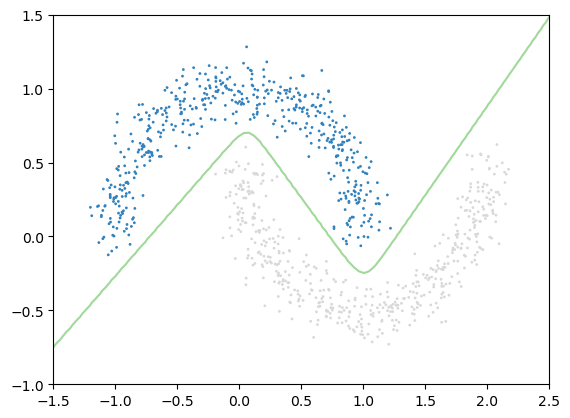import numpy as np
import matplotlib.pyplot as pl☑ Multi-layer Perceptron
1 Linear Separability of Binary Classification
Consider the training data:
- Inputs: \(X = \{x_i\in\mathbb{R}^d\}\)
- Labels: \(Y = \{y_i\in\{0,1\}\}\)
We say that \((X, Y)\) is linear-separable if there exists some hyperplane in \(\mathbb{R}^d\) defined by
- \(w\in\mathbb{R}^d\)
- \(b\in\mathbb{R}\)
such that:
\[\forall i,\ y_i = \mathrm{sign}(w^Tx + b)\]
#
# Linearly separable dataset
#
np.random.seed(1)
ang = -45 * np.pi / 180
M = np.array([
[1.0, 0.0],
[0.0, 2.0]
]) @ np.array([
[np.cos(ang), np.sin(ang)],
[-np.sin(ang), np.cos(ang)]
])
L = 3
x0 = np.random.randn(1000, 2) @ M + np.array([-L, L])
x1 = np.random.randn(1000, 2) @ M + np.array([L, -L])
figure = pl.figure(figsize=(6,6))
ax = figure.add_subplot(1,1,1)
ax.scatter(x0[:, 0], x0[:, 1], s=1)
ax.scatter(x1[:, 0], x1[:, 1], s=1)
#
# Separation
#
ax.plot([-8, 8], [-8, 8], '--')
ax.set_aspect('equal');
#
# Linearly inseperable dataset
#
import sklearn.datasets
x_donuts, y_donuts = sklearn.datasets.make_circles(1000, noise=0.05, factor=0.5)
x0 = x_donuts[y_donuts == 0]
x1 = x_donuts[y_donuts == 1]
figure = pl.figure(figsize=(6,10))
ax = pl.gca()
ax.scatter(x0[:, 0], x0[:, 1], s=1)
ax.scatter(x1[:, 0], x1[:, 1], s=1)
ax.set_aspect('equal')
ax.set_title('Linearly Inseparable Donuts');
2 Kernel Methods
Suppose \(\{(x_i, y_i)\}\) is not linearly separable. Can we find some transformation \(\phi\) such that \(\{(\phi(x_i), y_i)\}\) becomes linearly separable?
Yes.
The function \(\phi\) is called the kernel.
def kernel(x):
r = np.linalg.norm(x, axis=-1)
return np.concatenate([x, r[:, None]], axis=-1)kernel(x_donuts)[:5].round(3)array([[ 0.034, -0.575, 0.576],
[-0.078, 0.552, 0.558],
[-0.819, -0.713, 1.086],
[ 0.09 , -0.518, 0.526],
[-0.452, 0.139, 0.473]])#
# Linear separation in higher dimensions
#
x_new = kernel(x_donuts)
x0_new = x_new[y_donuts == 0]
x1_new = x_new[y_donuts == 1]
fig = pl.figure()
ax = fig.add_subplot(projection='3d')
ax.view_init(15, 25)
ax.scatter(x0_new[:,0], x0_new[:,1], x0_new[:,2], c='red')
ax.scatter(x1_new[:,0], x1_new[:,1], x1_new[:,2], c='blue')
ax.set_title('Linearly separable after kernel transformation')
xx, yy = np.meshgrid(np.linspace(-1, 1, 100), np.linspace(-1, 1, 100))
z = 0 * xx + 0.8
ax.plot_surface(xx, yy, z, alpha=0.2, color='red');
3 Learning Nonlinear Transformation
import sklearn.datasets
import pandas as pd
pl.set_cmap('tab20c')
(x_moon, y_moon) = sklearn.datasets.make_moons(1000, noise=0.1)
pl.scatter(x_moon[:, 0], x_moon[:, 1], c=y_moon, s=1);
We can incorporate the non-linear kernel transformation as part of the classifier model.
The model now has two layers:
- Transform input to a higher dimension:
\[z = \sigma_1(xW_1 + b_1)\] where \(W_1\in\mathbb{R}^{2\times k}\), and \(b_1\in\mathbb{R}^k\) and \(\sigma_1\) can be any non-linear activation function.
Perform classification:
\[ \mathrm{sigmoid}(zW_2 + b_2) \] where \(W_2\in\mathbb{R}^{k}\) and \(b_2\in\mathbb{R}\).
In general, the overall model architecture is given as:
\[ x:\mathrm{Input} \underbrace{\longrightarrow}_\mathrm{hidden} z:k \underbrace{\longrightarrow}_\mathrm{classify} p:c \]
This is known as the multi-linear perceptron (MLP) where
- \(k\) is the hidden dimension
- \(c\) is the number of classes
4 MLP in PyTorch
import torch
import torch.nn as nn4.1 The model
class MLPBinaryClassifier(nn.Module):
def __init__(self, input_dim, hidden_dim):
super().__init__()
self.hidden = nn.Linear(input_dim, hidden_dim)
self.output = nn.Linear(hidden_dim, 1)
def forward(self, x):
x = self.hidden(x)
x = nn.functional.softmax(x, dim=1)
x = self.output(x)
x = torch.sigmoid(x)
return x4.2 Training
x_input = torch.tensor(x_moon, dtype=torch.float32)
y_true = torch.tensor(y_moon, dtype=torch.float32).reshape(-1, 1)model = MLPBinaryClassifier(2, 10)
optimizer = torch.optim.Adam(model.parameters(), lr=0.1)
loss = nn.functional.binary_cross_entropyepochs = 10000
for epoch in range(epochs):
optimizer.zero_grad()
l = loss(model(x_input), y_true)
l.backward()
optimizer.step()
if epoch % (epochs//10) == 0:
with torch.no_grad():
print(epoch, l.numpy())
print(epoch, l.detach().numpy())0 0.7031396
1000 0.00036938215
2000 0.00010792634
3000 4.6887973e-05
4000 2.3616216e-05
5000 1.2775891e-05
6000 7.174313e-06
7000 4.121147e-06
8000 2.390107e-06
9000 1.4174445e-06
9999 8.0992186e-074.3 Visualizing classification boundary
x_lim = np.linspace(-1.5, 2.5, 100)
y_lim = np.linspace(-1, 1.5, 100)
xx, yy = np.meshgrid(x_lim, y_lim)
x_input = np.array([xx.ravel(), yy.ravel()]).T
x_input = torch.tensor(x_input, dtype=torch.float32)
x_input.shapetorch.Size([10000, 2])model.eval()
z = model(x_input)
z = z.reshape(100, 100).detach().numpy()
z.shape(100, 100)pl.set_cmap('tab20c')
pl.scatter(x_moon[:, 0], x_moon[:, 1], c=y_moon, s=1)
pl.contour(xx, yy, z, levels=1);
5 PyTorch Sequential Module
class MLP(nn.Module):
def __init__(self, input_dim, hidden_dim):
super().__init__()
self.layers = nn.Sequential(
nn.Linear(input_dim, hidden_dim),
nn.Softmax(dim=1),
nn.Linear(hidden_dim, 1),
nn.Sigmoid(),
)
def forward(self, x):
return self.layers(x)#
# train
#
x_input = torch.tensor(x_moon, dtype=torch.float32)
y_true = torch.tensor(y_moon, dtype=torch.float32).reshape(-1, 1)
model = MLP(2, 10)
optimizer = torch.optim.Adam(model.parameters(), lr=0.1)
loss = nn.functional.binary_cross_entropy
loss(model(x_input), y_true)tensor(0.7080, grad_fn=<BinaryCrossEntropyBackward0>)epochs = 5_000
for epoch in range(epochs):
optimizer.zero_grad()
l = loss(model(x_input), y_true)
l.backward()
optimizer.step()
if epoch % (epochs//10) == 0:
with torch.no_grad():
print(epoch, l.numpy())
print(epoch, l.detach().numpy())0 0.70800835
500 0.0012570171
1000 0.00041307812
1500 0.00020677462
2000 0.00012206836
2500 7.862232e-05
3000 5.33808e-05
3500 3.751982e-05
4000 2.6998929e-05
4500 1.9755698e-05
4999 1.4646525e-056 Visualize separation boundary for MLP
x_lim = np.linspace(-1.5, 2.5, 100)
y_lim = np.linspace(-1, 1.5, 100)
xx, yy = np.meshgrid(x_lim, y_lim)
x_input = np.array([xx.ravel(), yy.ravel()]).T
x_input = torch.tensor(x_input, dtype=torch.float32)
x_input.shape
model.eval()
z = model(x_input)
z = z.reshape(100, 100).detach().numpy()
pl.set_cmap('tab20c')
pl.scatter(x_moon[:, 0], x_moon[:, 1], c=y_moon, s=1)
pl.contour(xx, yy, z, levels=1);